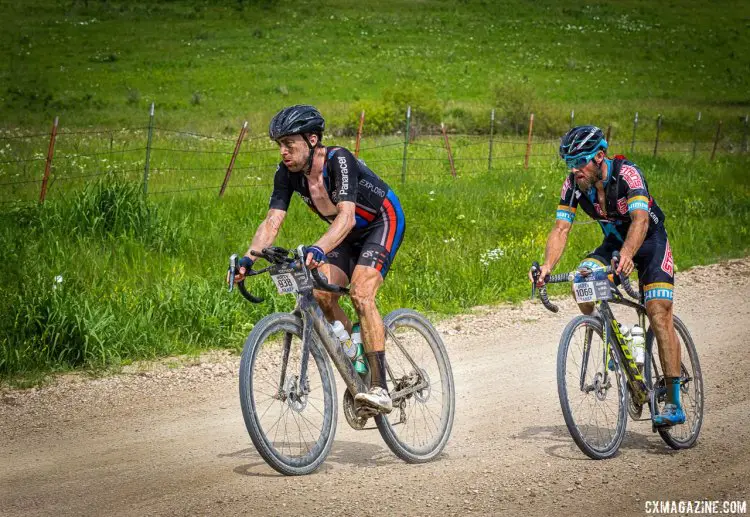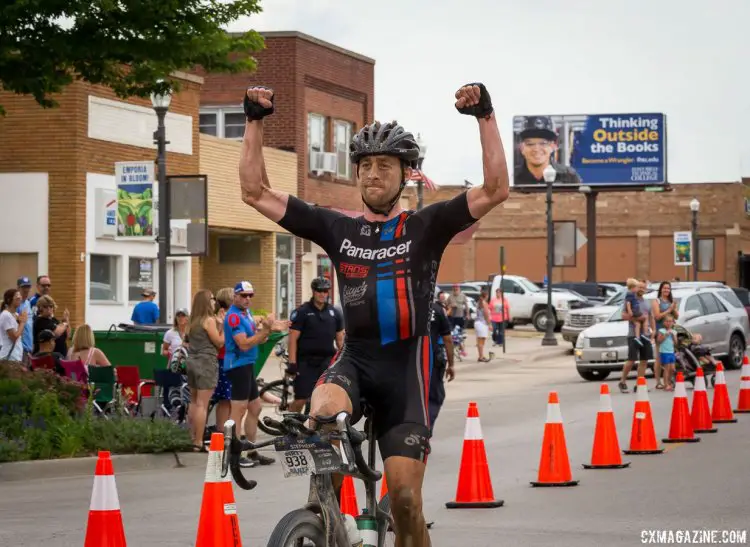
Our coverage of the 2018 Dirty Kanza 200 is brought to you in part by Panaracer. Check out its line of gravel tires for your next adventure.
Updated May 29. The Dirty Kanza 200 has become the premier gravel race on the annual calendar, with an increasing number of professional racers targeting the annual 200-mile race through the Flint Hills outside Emporia, KS. “Winning Dirty Kanza is every rider’s season goal,” said Mat Stephens about the event. “It’s the biggest gravel race of the year. It put me on the gravel map and does so for anyone that wins it.”
In 2017, Stephens won the Dirty Kanza 200 and in turn, put his name at the forefront of the gravel scene. This year, he returns as the defending champion, with a number of athletes looking to claim his throne.
For Sven Nys, Michael van den Ham, Geoff Kabush and others, the task of knocking off Stephens will not be an easy one. The former Pro Road Tour racer comes into the race on a roll after winning Land Run 100 and setting a new course record at the Barry-Roubaix.
We have been following Stephens quite a bit as part of our gravel coverage and reached out to him to ask him how he is feeling about this year’s Dirty Kanza 200 and how he sets up his 3T Exploro Flatmount for success. Stay tuned for more coverage of Stephens and all the other athletes with our on-site coverage of the 2018 Dirty Kanza starting next week.
Interview with Mat Stephens, Dirty Kanza 200 Defending Champion
Cyclocross Magazine: Big spring for you so far with wins at Land Run and Barry-Roubaix, how are you feeling coming into the 2018 Dirty Kanza 200?
Mat Stephens: I’m undefeated this year on gravel so it’s hard to not have confidence going into the race. But over 200 challenging miles, anything can happen so I’m just going to line up and do my best.
CXM: Anything change with your training this year? How much do you monitor watts or heart rate during the event?
MS: Last year I raced a number of Pro Road Tour events on the road and this year I have left those out and focused more on gravel races with lots of road training. It’s similar but different.
Last year I only used a heart rate monitor during the race while using a power meter in training. This year I have a power meter on my gravel bike and it’s been cool to see what the races really require. For Dirty Kanza 200 I will have a great idea what I can do on the day and how to “pace” myself. Pacing yourself in the race is kind of laughable though, you just stay with the leaders and hope for the best.
CXM: Excited about racing against Stan Nice slash Sven Nys?
MS: Stan’s products are Nice aren’t they? I’ve watched and rooted for Sven for years on TV, but at the start line he is just another competitor and another obstacle to overcome. I raced and beat another World Champion on gravel in his “first race back” in 2017. I treated him the same as the other competitors that day, I shook his hand and said good race and stood on the podium for pictures. Of course that picture has a better story to tell than any other podium pic though.
CXM: Thoughts on the growing number of pros targeting Dirty Kanza? Looks like you’re going to be in for a tough fight this year. How important is defending your title in terms of your season’s goals?
MS: Technically I am an ex-pro too, so I’m not surprised “we” are showing up. We enjoy riding our bikes, the challenge of the day and the competition. Put some prestige on the line and it was bound to attract talented and competitive riders sooner or later.
For sure it’s tough and it’s going to be really hard for a non-pro or non-full time rider to win this event anymore. The level of competition is too high. Look at the average speed for the winner! They have climbed from 14 or 15mph to 19-plus mph!
Winning Dirty Kanza is every rider’s season goal. It’s the biggest gravel race of the year. It put me on the gravel map and does so for anyone that wins it. However, the pressure is on those that haven’t won it.

Mat Stephens held off a tough challenge from Jake Wells to win the 2017 Dirty Kanza 200. © Christopher Nichols
CXM: One could argue you are the man to beat at any gravel race you do right now. How does that affect your preparation and racing?
MS: My preparation is the same, I train my best and race as hard as I can. Focusing on external factors is rarely productive, so that’s just wasted energy. During the racing this year I have definitely been aware that other riders are not wanting to contribute as much to the pace-making or are looking at me to make the moves. I just accept it and take it as part of the puzzle I have to solve.
CXM: How much research do you do on your competition for gravel races?
MS: There are a lot of new faces at every gravel race so I try not to drive myself crazy researching everyone. I just study how they are riding out on the course and size them up then. The races are pretty long so there’s plenty of time. *smiles*
CXM: Are you still riding the 3T Exploro? Anything new with your setup this year?
MS: Yes! And Yes. It’s the new “3T Exploro Flatmount” version. Same design overall with a few tweaks like flatmount brakes, a new seatpost clamp and 12mm thru-axles. Still the fastest gravel bike on the planet.
CXM: How do you make your tire choices for races?
MS: I check the weather, the course, and consult the local shaman. Luckily, Panaracer has a nice range of tires available, and so far this year I have used 32mm and 38mm Gravel King slicks and 32, 35, 38 and 43mm Gravel King SKs. The 3T has plenty of clearance to run whatever I think is best. I just match the width and tread design to the course conditions and send it.
CXM: Tubeless setups sometimes require a little time to “cure” for the most airtight setup. Do you bring multiple treads and sizes with you and ever make a change the night before a race based on pre-ride or weather? What’s your pre-race tire and sealant check routine? How many days out?
MS: It depends on how much course scouting I am able to do as to when I install my race-day tire. If it’s a new course, then I may have to wait until I arrive at the race town to make a decision on my setup. Ideally, I would set up two to three days out so I get a chance to do a ride on the the setup before race day. Honestly, I am a bit spoiled with Stan’s wheels and sealant and Panaracer tires, so I have even made last minute changes hours before the race based on weather or course reports. Both are super-easy to set up and have been rock solid.
CXM: Jake Wells said he’s bringing aero bars this year. You plan on giving him a hard time for copying you? Are the bars’ value for you more about cheating the wind or having an alternative riding position?
MS: Why would I give someone a hard time for copying a good idea?! If someone is too dumb or proud to adopt a beneficial strategy, well I’ll just let them flounder on their own. Bars, tires, I analyze everything to see what puts me in the best position to win.
CXM: What are you carrying with you on race day? Does that change much between events?
MS: Yes, I change my “kit” based on the length of the event and what level of support is allowed. As the race gets shorter or more support is allowed, I drop weight where I can with a smaller multi-tool or less spare parts. On some multi-day trips I will take things like lube, needle and thread and extra Stan’s Sealant. I take a pretty standard kit on race day: Multi-tool, quick link, tubeless plug, derailleur hanger, CO2 cartirdge, tire lever and spare tube.
CXM: Thanks for your time. See you in Kansas.
MS: Thanks.





























